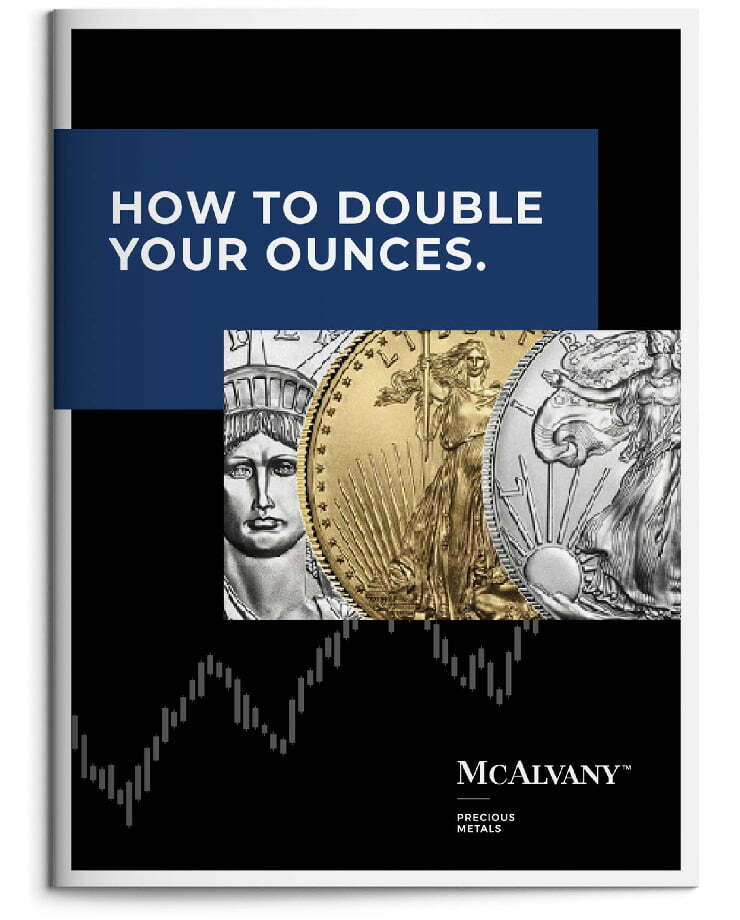Podcast: Play in new window
- Could A Breakdown In Bonds Break The Stock Market?
- Bessent Pressures Bank Of Japan For A Stronger Yen
- Would Trump Sue The Fed?
“We are spending around 600 billion a month, and the US political class has been unwilling to meaningfully cut spending to address our debt issues. Obviously the hope is that we grow our way out of 37 trillion. By the way, we tipped over 37 trillion last Monday, and so we’re on the fast march towards 40 trillion in debt. And at the current deficit pace, that’s either one, maybe two years out.” —David McAlvany
* * *
Kevin: Welcome to the McAlvany Weekly Commentary. I’m Kevin Orrick, along with David McAlvany.
David, the stock and the bond market are interesting. The way a broker looks at the stocks and bonds usually is that if the stock market is high and starts to break down, that money usually will move into bonds, yields will fall, bond values will rise. That actually is what we would consider a relatively healthy move.
But if the bond market is already high and it breaks down and pulls the stock market with it, that creates an anomaly, doesn’t it?
David: It does, and it was interesting to hear Goldman Sachs in May of this year comment that the reason you should have gold in your portfolio is because the relationship between stocks and bonds was breaking down, and both were moving lower. Of course, that was apropos if you’re thinking the April timeframe.
But they’re observing this and it should not happen that both move the same direction. You should get some benefit, and if bonds are not a safe haven, gold remains a go-to asset. Again, Goldman Sachs, late May.
Kevin: Right. And it’s good to think of the bond market like a seesaw or a teeter-totter. If interest rates rise, the value of the bonds go down. If interest rates fall, the value of the bonds go up. Right now, Japan, Germany, France, the United States, the UK, Canada, right now, you’ve been talking about the possibility of interest rates going up, bonds going down.
David: Yeah. With those countries, what they have in common at the moment— Again, it’s a short list: Japan, Germany, France, the US, UK, Canada, Australia.
Kevin: Can you make an acronym out of that, Dave?
David: I think you can. It would be JGFUUCA.
Kevin: So, that’s a little different than BRICS, right?
David: It is different than BRICS, but everything gets an acronym eventually.
Kevin: Right.
David: That list is not exhaustive, but there is a common characteristic.
Kevin: And the yields are getting ready to break out to the upside, possibly.
David: Yields are threatening to break out to the upside. You survey the charts of those countries, particularly their long bonds. The yields are bumping up against higher levels. Each time they test the upper bound, there’s an increased probability of a break, a break higher.
And of course, the inverse of yield is price. The price of those bonds paints the inverse picture, and it looks like a tap dancer on thin ice. Lots of activity at one level for an extended period of time, threatening to break down in price.
Kevin: What does that mean?
David: There is a reasonable shot at a bond bear market that negatively impacts a huge part of the developed world, and the developed world economy with, again, those epicenters being notably Western. Call it another leg in a global bond bear market. We’re perhaps finishing the intermission after watching the first act unfold between 2020 and 2023.
Kevin: Okay, but you stressed that it’s the western side of this. On the eastern side, are they lowering rates?
David: Notably different, you see a trend in the opposite direction where yields are going lower. South Korea, Singapore, and China stand out. Again, yields trending lower in what Trump could only dream of here in the United States. He’d love to see lower rates. We’re getting the opposite.
Don’t get me wrong, nominal yields in many of the BRIC countries are orders of magnitude higher than the short list just mentioned.
Kevin: Some are double digit, I think.
David: Yeah, Brazil and South Africa are both in the double digits. The contrast and the concerning element for the—what do we call it? JGFUUCA—
Kevin: You’re going to have to be careful how you pronounce that.
David: I know. It’s going to be an acronym. It’ll be adopted. —is that most of them have been in the privileged position of borrowing a lot of money at very reasonable rates. The concern centers on a move to levels in interest rates that make current debt levels unsustainable. We already have fiscal pressure in the US from rolling over short-term debt at considerably higher rates. The UK is very much in that same boat.
Kevin: We do consider Treasury’s still a very safe asset if it’s on the short end of the curve, right?
David: Absolutely. We think of the Treasury market as a safer place to allocate capital, and that’s particularly so at the short end of the yield curve, two years and under. That would be true of a couple of those countries mentioned, too: Germany, Japan, and the US. They make up the top three in terms of most-liquid government bond markets, not necessarily in that order.
Yet the stress shows up in the charts even for these very liquid markets. And I think these bond markets may hold the key for the equity markets.
Kevin: The equity markets right now are, again, at all-time highs. The Buffett ratio is very high. We’re coming into the week, Dave, that we’ve talked about 18 years, now, in a row: Jackson Hole. And usually there’s announcements at Jackson Hole that make a difference on not just the bond market, but the equity market.
David: Yeah. This soirée has been taking place since 1978. It was originally sponsored by the Kansas City Fed, and the invites would go out to your top central bankers from around the world. It’s a mix of monetary and fiscal policymakers from around the world. The Federal Reserve in the Wyoming mountains, notable folks are showing up as we speak, and these decision makers gather to discuss white papers, debate appropriate actions in the current context. It is the Global Geek Squad.
On occasion, the trends set from Jackson Hole have significant market implications. I think of Ben Bernanke’s 2010 hinting at QE2, which was very encouraging for equity speculators. 2012 again, he did the same thing, hinting at QE3. And markets are looking for reasons to be enthusiastic or afraid, usually looking for reasons to be enthusiastic.
Kevin: And that’s why the timing of this might be really interesting. You didn’t say that yields are definitely breaking up to the upside. You said that we’re on thin ice.
I remember, Dave, walking to junior high every day. In the winter time, the lake would ice over and it would cut the route quite a bit. But if you got out a little bit too thin on the ice on the spring, usually one of the junior highers ended up falling—
David: Went swimming.
Kevin: —yeah, falling through. So, we’re on thin ice. You’re not saying it has to happen right now?
David: No. In fact, probabilities are that we get a rate cut of 25 basis points—over 80% probabilities as the market’s currently pricing it in September. That, again, is when the market finds something unexpected. If they’re expecting a rate cut of 25 basis points, they don’t get what they want, there’s a temper tantrum that’s thrown.
Just because yields have risen and threatened to break out doesn’t mean they will. But having notable bond markets around the world tap dancing, if you will, as they are in thin ice, that’s what you see in current pricing. At the same time, equity markets are at, as you mentioned, egregiously overvalued levels.
Kevin: Right.
David: And it leaves a few scenarios open. If you looked for an autumn sell-off in equities, you could see some benefit going to those vulnerable-looking bond markets, helping with the reversal in yields to lower levels as money migrates to more liquid fixed income positions out of risk assets. That’s one scenario.
Kevin: Yeah, that can actually really help a bond market where the yields are rising, is a stock market breakdown. But going to where we started, there are times when the bond market breaks down and the stock market breaks down. That’s when it’s dangerous.
David: That’s what Goldman Sachs was noting—
Kevin: Yeah.
David: —in May about the behavior of both markets in April. The more dangerous potential outcome is that bonds move first, break down—again, that’s prices lower and yields higher—and fixed income sets the tone for risk assets. Then an equity move lower in that context would not necessarily benefit fixed income, and the trading tone already negative, the price action presenting another way to lose money, going from the equity frying pan into the fixed income fire, there’s no way to preserve value.
Kevin: Okay, so it is good to watch rates. I was just laughing. I joke about how you will easily read a 650-page book on interest rates, and I typically won’t, Dave. I have other things that I like to read. But sure enough, on your shelf there is a, what is it, 650-page book on interest rates. The reason you read those books is because this really is important.
David: Yeah. Homer and Sylla wrote the tome. For those less interested in interest rates, maybe The Price of Time, our guests earlier this year.
Kevin: Yeah, that was a good book. And it was shorter, by the way.
David: Yeah, by half. It was only 300 pages, but very readable.
Kevin: So, again, if bonds move first, along with currencies, that could be tough on equities because the equities are so high right now.
David: Yeah. And I think that’s the combination we’ve been lingering on for some time. As we’ve said repeatedly all year long, watch the bond market. Watch the currency markets. If bonds move first along with currencies and the tone’s set in equities, it would just be a terrible one, frankly. It’s like having your safe haven set on fire just before you panic from a risky asset portfolio. What do you do? Where do you go? If not Treasuries, then where?
Kevin: Well, and I think it’s important to point out that most brokers follow the model—almost always—that when stocks go down, bonds go up. And that’s not necessarily always the case. Now, if stocks move first, that model actually does work. Let’s say the stock market starts to break down, bonds would not be a bad place to be.
David: Right. Stocks move first. Bond market could be spared some pain, providing a haven for the crowd exiting risk assets. And the challenge with this, the counterpoint arguing against it, bond traders are aware of inflation risk before stock traders are really giving it a second thought. Last week’s PPI, Producer Price Index, and CPI, Consumer Price Index, both bumped higher. And it challenges the inflation normalization hopes of the equity market and frankly, of the Trump administration. If inflation continues to creep higher, watch out.
Kevin: Wouldn’t you consider the bond market more intellectual and the stock market more emotional, if you had to pick types of personalities for markets themselves?
David: Absolutely. You’re focusing on elements that can be put into an equation and have a little bit more rigor when you’re talking about bond trading. And equity trading is a little bit different. Certainly, you can get very quantitative. But typically, you see the equity crowd feeding off of momentum and enthusiasms. And depending on if you’re a hedge fund or a retail investor, the hedge fund doesn’t care if it’s up or down. They just love volatility. They love momentum in either direction. The retail investor really only knows long only, and tends to overextend at the end of a market cycle, which really puts them with only one strategy to follow, which is exit the market.
Kevin: So, this takes us to, if bonds are a negative catalyst, what you’re saying is the smart people are leaving the room. You should probably pay attention if you’re an equity holder.
David: And I think today, if you’re looking at fiscal tolerances being tested, the bond market puts up with a lot until the day that it doesn’t. And you look at the 10-year, you look at the longer dated Treasuries, and they’ll tell you what bond traders think about D.C.’s decision making.
Kevin: Okay. So, inflation stats, as we go into the August stats, that’s probably something to watch.
David: Yeah. I think the August inflation stats will be worth watching. Other bond market catalysts are certainly out there. And if you’re looking for a particular catalyst, maybe it’s the US printing a monthly budget deficit over 300 billion. For July, we were at 291. I think that’s top three for any July in the history of the country. 291 billion for July was treated as manageable. Still near record levels. But if you think about that, that’s just the deficit portion. We are spending around 600 billion a month. The US political class has been unwilling to meaningfully cut spending to address our debt issues. And obviously the hope is that we grow our way out of 37 trillion. By the way, we tipped over 37 trillion last Monday, and so we’re on the fast march towards 40 trillion in debt. And at the current deficit pace, that’s either one, maybe two years out.
Kevin: I was at the breakfast table this morning with my wife and she goes, “Oh, it’s a Commentary day. You guys are going to record the Commentary. It’s a good day.” I said, “Yeah, but it’s getting tougher because really we record the Commentary and it’s aired the next day.” And think about last week, Dave. We didn’t know from one Trump announcement to the next what was going to happen, so all we could do is speculate. With the Federal Reserve, is there an announcement that Trump could make that could change the tone of what you’re talking about?
David: Yeah. And well, last week what was less speculative is that JPMorgan was under pressure given their positioning in the gold market.
Kevin: And you pointed that out even when the Trump tariffs look like they were on gold.
David: Right. Which for us meant this is not going to last long, because it’s not what you know, it’s who you know and who you have on speed dial. So, there’s many things that could be catalysts for concern amongst the global bond investor, particularly as it relates to US Treasuries. Maybe bonds react to Trump’s landing a lawsuit on the Federal Reserve.
Kevin: And he’s talked about that.
David: Yep. Putting pressure on in order to punish Powell for not doing what he “should be doing with rates.”
Kevin: One of the things we’re seeing is the Trump administration definitely is getting countries to line up in ways behind them, like what we’ve seen with Zelenskyy in Ukraine and Putin and Russia. But Bessent right now is putting a lot of pressure on the yen. He’s pressuring the Japanese central bank.
David: It’s pretty uncharacteristic for the US Treasury chief to have much to say about someone else’s monetary policy. And here he is braying against the yen, arguing for a stronger yen. And implicit to that is a lower dollar. The question is, does that become a catalyst for motivating a further exit from Treasuries? Maybe the Federal Reserve’s claim of substantial progress on inflation is determined to be challenged or fail. Substantial progress, yes. But we’ve spent 53 consecutive months over the 2% inflation target.
Kevin: Yes. But the financial markets, yeah, they’re high. They’re at all-time highs, but unemployment is low. The economy is strong right now based on the numbers.
David: Well, and I think this is one of the reasons why, even though the market is assuming an 80% probability of cutting rates by 25 basis points, financial markets are strong, at all-time highs, unemployment is low. The economy has remained strong. The tariff-driven inflation has been modest to this point. Yes, some evidence of it, particularly in PPI. But I think that just makes it difficult to consider a rate cut in September. And to do so would certainly propel asset markets higher, but at what cost? And I think this is where, whether it’s Bessent or Trump, they’re really not counting that cost. There’s an urgency. There’s an urgency to propel asset prices higher.
Kevin: Well, and speaking of Jackson Hole, you remember 2020, Powell talked about averaging out that 2% target that they had. You just now said that we’ve had 53 consecutive months over the 2% inflation target.
David: Yeah. The argument in 2020, and this was kind of the breaking news headlines from that Jackson Hole meeting, circa 2020, he was arguing for an average inflation target. Instead of 2% firm, we were willing to let inflation run a little hot because it had run cool long enough.
Kevin: So, we’ll go 3, 3, 3, 3, 3, 1, 1, 1, 1, 1, and average it out to 2? That was his idea?
David: Exactly. We’d run below target for a number of years. It was okay to run above target, so long as the average over time was in the 2% range. But how long does an average inflation targeting framework remain credible? I mean, are we at the edge of what the bond market will tolerate from such a scheme, where again, you’re talking about just a slight move higher in inflation and all of a sudden the idea that it is controlled, it is being managed— Again, to quote Powell, “We’re making substantial progress.” At what point do you call balderdash?
Kevin: Well, yield curve control almost always spells inflation, because yield curve control is what they’re talking about. Won’t they talk about that at Jackson Hole?
David: It remains to be seen. Would Powell dare discuss yield curve control at Jackson Hole? Inflation appears to be more than a sticky issue—again, above target for nearly five years. If you throw yield curve control into the conversation, you have the makings of a currency cascade to lower levels. I think what they want is a controlled move lower, a gradual move lower in the value of the dollar, but the implementation of yield curve control would put a tremendous amount of pressure on the currency. And Michael Hartnett at B of A, he was keen in the last week or so to say this is exactly what you should expect. Yield curve control is coming, and gold makes all the sense in the world. So, we’ve got B of A, Michael Hartnett, decent analyst, and folks that run the commodity desk at Goldman Sachs saying, “Yeah, the disconnect between the stock market and bond market, where that 60/40 mix of both is supposed to provide you some sort of cover, not working that way in the last few iterations.” And I think they were referring back to 2022 as well, where that same relationship broke down, and 60/40 ended up being double punishment instead of a port in the storm there in the fixed income market.
Kevin: So when we are talking about that type of thing, like yield curve control or trying to control inflation, we think just about our own currency. But what Bessent is doing right now, pressuring the Bank of Japan, you can also adjust things based on just the way other currencies move against your own, right?
David: Yeah, for sure. In a fiat currency world, if our currency is weak, it’s going to show up as strong currencies elsewhere, or if their policies are directing their currency to higher levels, by default we are moving to a lower level. And it’s not necessarily sort of an unhinged inflation, it would be the desired outcome, which is a gradual devaluation of the currency to give us a trade advantage, and to do what Stephen Miran has described as the re-industrialization of the country. Bessent was not only pressuring the Bank of Japan last week, his comment was, “They’re behind the curve in raising rates to address inflation.”
But I think it’s also a bit of the pot calling the kettle black, because while he wants them to strengthen their currency, he’s also pressuring the Fed to lower rates by 50 basis points, not 25, in September, and eventually as much as 150, proving, it would seem, that he has friends still in the hedge fund community, more so there than in the broader population. What happens with the stimulus of a 50, 75, 150 basis point reduction in rates, asset prices go bonkers to the upside. It may be bad for the currency, but it could be great for stocks. And again, the broader population’s more concerned about the price of a loaf of bread or a gallon of milk, not necessarily the share price of Nvidia. So he may be playing some favorites. What he said is, “If we look at any model, we should probably be 150, 175 basis points lower,” to quote Bessent.
Kevin: How about quoting, actually, one of our guests, Taylor? Has he ever heard of John Taylor before?
David: Yeah. The Treasury chief, I think, is forgetting the Taylor rule. The Taylor rule has been trending higher since the third quarter of 2024, and the fed funds rate is about where it should be according to the Taylor rule. Powell, in this point, is not wrong. It’s Bessent who has missed— He says he can’t find a model that justifies where we’re at. How about one of the most time-tested models as it relates to inflation and interest rates?
Kevin: 54 years ago I was eight years old, and Nixon took us off the gold standard. That actually makes me very mad. I’ve loved my career in gold with you, Dave, but I should have never had it, to be honest with you. The dollar should have continued to be on the gold standard. In 1971, Nixon took us off. At that time, he said it would be temporary and the gold window wouldn’t be shut forever, that the dollar wasn’t going to lose any of its value. Now, in my lifetime, I had to own gold, because the buying power of what I make and what I can save has lost over 90% of its value. What we’re seeing here with Bessent, okay, not that we disagree with everything that he’s saying, but what we’re seeing is a complete disregard for the devaluation of the dollar.
David: Yeah. Nixon, “What is this action?” This is what he said in ’71, “What is this action, which is very technical, what does it mean for you? Let me lay to rest the bugaboo of what is called devaluation. Your dollar will be worth just as much tomorrow as it is today.”
Kevin: How’d that work out for you? Like our buddy, Bill King, says, “How’d that work out?”
David: Yeah, well that’s your 90% devaluation. That’s your 90% loss of purchasing power since 1971. So it’s not out of the realm of possibility that we have significant currency pressure in the years ahead, and we have sort of inflation unhinged. But these, again, would all be sort of catalysts for the bond market selling off, the stock market coming under pressure. Considering a short list of catalysts, again for negative bond market dynamics, what that neglects is the normal pendulum swings, which require no catalyst at all. Bloomberg noted last week that corporate credit spreads are at 27-year lows.
Kevin: It’s amazing. You can buy a Treasury or you can buy a junk bond, and you’d get about the same amount of return.
David: Well, investment grade spreads to Treasuries are a mere 73 basis points. The gap between them, you’re getting—
Kevin: Less than 1%.
David: Yeah, less than 1%, and that’s the tightest spread in 27 years. The contrarian would argue that getting to market extremes argues for a reversal. Again, sort of the pendulum swinging, the pendulum swings back the other direction. Thus far it has not happened. So maybe 73 basis points become 65 basis points before we see credit spreads widen again, but that would be very critical.
And then, again, when we say watch the bond market, it’s not just watching government bonds and their yields, it is the relationships between bonds where you can see incredible stress emerge. So spreads are an incredible tool, if you will, or tell, if you’re looking for data to confirm real stress in the fixed income markets.
Kevin: Well, and how about with equities? Okay, so Buffett, 25 years ago, back when we were in the tech stock bubble, he was warning people about when the equity markets are more than 200% over what the GDP is. Where are we at now on the Buffett ratio?
David: And again, I think this points to not needing a catalyst for a reversion to the mean in equities or in bonds. Markets do fall of their own weight. And equities at 208% of market cap to GDP—
Kevin: Wow. That’s the Buffett ratio, 28, 208 right now.
David: Yep. It can fall of its own weight. Buffett’s comment, December of 2001, Forbes magazine, “If the ratio approaches 200, as it did in 1999 and a part of 2000, you are playing with fire.” It took on the name “the Buffett ratio” back in 2001 when Buffett was basically saying, “This is my favorite valuation of equities.” And just as it indicates when things are overpriced, it also indicates, on the other extreme, when the pendulum has swung, when things are undervalued. But categorically we are approaching 200. In fact, we’ve blown past 200. And I would agree with Buffett, we’re playing with fire.
Who is playing with fire? Retail participation and risk assets continue to gain momentum. Playing with fire, those are the watchwords. If you’re thinking as the retail investor today, you would ignore that completely and you would say, “Yeah, yeah, we’ll let the Cassandras, we’ll let the old men worry about these kinds of valuations.” Warning signs are, to the enthusiastic retail buyer, nothing more than excuses of cowardice. They’re looking at the other side and translating it differently. They’re saying you failed to participate, and it’s an expression of missing out. It’s an expression of fear of missing out. That’s what shows up to me when you’re looking at a 208% market cap to GDP ratio.
Kevin: Well, so let’s talk about catalysts. Because in history we go back and we go, “Oh, so that’s what caused that.” But rarely ever do we know ahead of time what the catalyst is. Could the pendulum swing without a catalyst?
David: Yeah, and I think that’s the deal. Without a catalyst, you’re basically counting the buyers—this is specifically in the equities markets—you’re counting the buyers and you’re watching the margin levels. Last buyer in or the last margin dollar invested, and the market turns from positive upside momentum to negative downside momentum, and it does it in a hurry. We’re closer to that by the day. It was last week or the week before, we talked about the margin numbers crossing the one trillion mark, and highest level in nominal terms, also the highest level as a percentage of GDP. This blows away the numbers we saw at the market peak in 1929.
Kevin: Wow.
David: This is an expression of speculation in the marketplace today that is ignoring risk. We are closer by the day.
Kevin: Okay. So looking at momentum, are we gaining momentum or losing momentum?
David: No, I think momentum has already turned. As recently as June, 85% of the NASDAQ 100 companies were trading above their 50-day moving average. Last week you’re down to 50% of the NASDAQ 100 trading above their 50-day moving average. You’re beginning to see a waning of momentum to the upside.
And you look at all these other factors, VIX is trading at 15, that’s relatively low. Anything close to 10, and certainly as you get into the single digits, the pendulum swings hard the other direction. You still have dollars flowing into corporate credit, about $3 billion a day. No one is worried about risk in the junk bond market. No one is worried about the extra probability of default with someone who’s having to pay more—traditionally has paid significantly more—to borrow money. Yields have come down because money has been chasing yields and has pushed prices up, brought yields down. That’s where those spreads get really, really tight. But when you get spreads that tight, you are at an inflection point.
Kevin: Okay, so you talked about the VIX, which is the volatility index being at a low right now. Gold has platformed. Some people would say, well, it’s building a base for the next move, but that would also be an indicator right now that there’s uncertainty as to whether there’s a breakdown coming or not, right?
David: Yeah, and I mean the signature of a market top, you will typically have high volumes get you to a certain level and then it’ll break down pretty quickly thereafter. A retest of the market high, putting in at double top, very often the case. But for us to move sideways for four months— Just like bond yields are testing a ceiling, gold continues at sideways consolidation between 3,300 and 3,400, just below its April peak of 3,500. A break in the financial markets, whether it’s bonds or equities, I think that catalyzes gold in dramatic ways.
Kevin: Well, somebody must see it coming because look at the gold miners right now, Dave.
David: Yeah, the dynamics there, it is interesting. We considered the gold market last week, and asked the question about whether or not gold is over-owned.
Kevin: Right.
David: We discussed the pricing dynamics for coins and bars. Last week, the World Gold Council statistics, and then the anecdotes of what we see in our sister business, McAlvany Precious Metals, the melting pot is active.
There is so little interest that there is an abundance of product and it is literally being melted down so that it can be turned into exchange-deliverable bars. For those thinking that gold is over-owned, consider the recent polls from BofA’s show about a three and a half percent allocation across all portfolios, which would have some portfolios with no allocation and others maybe with a five or 10% allocation. But then you look at the miners as an expression of interest there too, and the gold miners have run, in terms of year-to-date performance, over 70% to the upside.
Kevin: Yeah, they’re screaming.
David: 70% gains year to date. You could suggest that’s an indication of being over-owned, but here is a very salient point. VanEck’s Gold Miners ETF, GDX. You can look at the performance of XAU and HUI. What’s helpful here is that GDX is an ETF, and when there’s more demand, you have to create new baskets to then buy more shares to meet retail demand for that ETF. We’ve seen shares outstanding actually shrink by 20%.
Kevin: So let me hear this right, so even though gold mining, the share price has gained 70%, we’ve actually seen the shares of outstanding ETF gold mining shares shrink. That shows a lack of interest.
David: Yeah, GDX is a proxy of interest for gold miners in general. They’ve shrunk their outstanding shares by 20% year to date by over 32% since 2020. So over the last nearly five years, you’ve got a 33% shrinkage in outstanding shares. This is not an over-owned space. Bloomberg calculates the profit margins of the average gold miner, if you go back just to the first quarter of 2024, at $647 per ounce. That was their profit margin, and first quarter of 2025, it had increased to $1,328. Move forward to Q2, that number is exceeding $1,700 an ounce in profit.
Kevin: So these companies are making profits right now hand over fist, and yet the public’s not participating yet?
David: That’s right. Gold is consolidating sideways, has for most of Q3, and if you look at the impact to the profitability, free cash flow for these companies, you’re talking about an extra $50 in margin growth just here in Q3 on a quarter-to-date basis. Free cash flow should again break all previous records.
Kevin: Isn’t that interesting, though, how little you hear about gold miners right now? You’re hearing about the S&P 500. You’re hearing about crypto, but not miners.
David: No. It’s interesting that the fact that gold miners have outperformed all—all—S&P 500 sectors year to date has not been recognized by the investment community. Again, consider that even as shares have appreciated, demand for the most significant ETF in the space has shrunk by 20%.
Kevin: Yeah, so what this says is this is a niche market right now that you want to be in before the public sees it.
David: With incredibly strong fundamentals and relatively low participation to date, there’s a strong case to be made for metals and metals-related allocations.
Kevin: So if those catalysts that we were talking about actually hit the bond market or the stock market, or even if the pendulum swings without the catalyst, you want to be in the market that nobody’s paying attention right now to?
David: Sure. I think catalysts for further growth, the migration of capital from risk assets in general, from fixed income and equities in particular towards hard assets, that’s ultimately motivated by a shift in sentiment in those other asset classes. There isn’t a lot of bullishness for gold or gold related assets today, silver related assets today because there’s still a tremendous amount of positive sentiment for those other asset classes. Shift the sentiment there, and I think you positively impact sentiment in the metal space.
Kevin: So we’re not really waiting for a news event here?
David: No. Catalyst or no catalyst— We may not have a policy decision or a market event that tips the scales and motivates the migration. It may well just be exhaustion on the upside.
So put that whole idea on pause. What if I’m wrong? Doug, on that last Tactical Short call, acknowledged an increasing likelihood of a crack-up boom. If that is the case, you’ve got all assets moving higher, and then it’s just a question of which assets are moving farther and faster.
So then all of a sudden it becomes, on a comparative basis, how are you doing in the context of a crack-up boom relative to the devaluation of your currency? Year to date, gold’s up 27%, silver’s up 31%. The miners are up north of 70%, versus bitcoin, which certainly is getting a lot of attention, 25%. The S&P 500, nine and a half. The Dow, 5.6%. It becomes, well, if the Dow’s got another 15 percentage points to run, that puts it at over 20% for the year, and it’s—
Kevin: It still doesn’t touch gold.
David: No.
Kevin: Or the shares, or the miners. So advice going into the last quarter of the year.
David: It’s the same as it was the first quarter of the year. From January to now, it’s the same. You’ve got to have a healthy cash position because you don’t know what downside volatility looks like in the stock market or the bond market. We may have a repeat of April. We may have a repeat of the first quarter of 2022 where you had anywhere from a 15 to 30% decline in equities, or more. You have to have a healthy cash position. You have to have a healthy metals position, and you have to have healthy allocations of patience and fortitude.
* * *
You’ve been listening to the McAlvany Weekly Commentary. I’m Kevin Orrick, along with David McAlvany. You can find us at mcalvany.com and you can call us at (800) 525-9556.
This has been the McAlvany Weekly Commentary. The views expressed should not be considered to be a solicitation or a recommendation for your investment portfolio. You should consult a professional financial advisor to assess your suitability for risk and investment. Join us again next week for a new edition of the McAlvany Weekly Commentary.
















